"Indrani"[1973] By Shorty from the original 7" recording. Uploaded by canchozl
Today I came across an article on soca music at NPR Music written by Baz Dreisinger. His refreshingly accurate description of soca reminded me of Mungal Patasar's recollections in the book "Mobilizing India" by Tejaswini Niranjana, which I have provided below and before the NPR article. I thought that others might find his thoughts interesting, especially since many do not know much about the East Indian influence in the genesis of this music genre and so do not always acknowledge it.
p. 88 -- In the 1980's a new form called soul-calypso, or soca, emerged, claimed by its inventor Lord Shorty (later Ras Shorty I) to have its inspiration in East
p. 89 -- Indian music. Shorty's songs "Indrani" (1973) and "Kelogee Bulbul" (1974) provided the genesis of the soca, marking clearly the Indian influence on calypso. In "Kelogee Bulbul," East Indian instruments like mandolin and dholak are used. The Trinidadian sitarist Mungal Patasar, an important experimenter with fusion music, provided this background:
Soca really originated from chutney. Ras Shorty I, who is the father of the soca, was singing calypso, and he went to practice in the bandroom, and the music arranger was playing reggae, and when he asked him how come you playing reggae, because there is a little thing about reggae and calypso, reggae taking over in Trinidad, although reggae originated in Trinidad. That much I can tell you, if you study the beat. Anyway, the guy say "Calypso is dead now, man, let's go for reggae." And that hurt him[Shorty] in a way, so he went back home. But he grew up amongst Indians, and he had a neighbor who used to play dholak and dhantal and ting. And he called me - that time I had a band called Sangam Sangeet in La Romain - and there's a drummer named Robin Ramjitsingh who used to play dholak, and he called me asked for a dholak player, and I sent Robin, and he did his first recording with Robin Ramjitsingh. The bass guitarist was trying to imitate the dhol, the left side of the dholak, and in trying to do that they created the beat with the bass guitar out of the dholak, and that's what they call "soca." The word was "so-k-a-h," the soul of calypso and an Indian beat, They used the word "kah" because it was the first letter of the Indian alphabet...The Africans try to say it is "soul" and "calypso." But it is not that. It is soul of calypso and Indian chutney. That would be the definition of soca.
Shorty, too, spelled the name "s-o-k-a-h" to indicate the East Indian influence, but the spelling did not stick, and other singers and those who wrote about music - disinclined to mark the East Indian input and suggesting instead a derivation from the African American musical genre soul and from calypso - assigned the new form the name "soca." Soca is different from calypso in that it is usually seen as music to dance to and for the most part, and unlike one of the key strands of calypso, does not talk about the political situation.
SOURCE: Mobilizing India: women, music, and migration between India and Trinidad. By Tejaswini Niranjana. Durham : Duke University Press, 2006
Soca: The Music Of Trinidad's Carnival.
By Baz Dreisinger
NPR Music | March 4, 2011 06:30 pm
Listen to the story:
Machel Montano performing in Port of Spain, Trinidad, in February.
Sean Drakes/CON/LatinContent/Getty Images
Carnival season on the Caribbean island of Trinidad boils down to one thing: fresh soca music. Consider it Red Bull for your ears, or music with a purpose.
"The intention of the energy of soca music is to really uplift people; really make them smile; keep them happy; make them celebrate even in the toughest times," says Machel Montano, soca's biggest star. "The economy is down — you hear some soca music, you're gonna want to go out and party, even if you have to borrow the money."
Soca stands for "soul of calypso," and it was pretty much invented in the 1970s by Trinidadian artist Lord Shorty, who claimed that the soul of calypso was as multicultural as his island's African and East Indian descendants. To set this post-colonial hybrid to music, Shorty sped up calypso and gave it an Indian twist.
In the 30 or so years since its invention, soca has evolved into the club-friendly, studio-produced music of a younger generation. Soca artist Kees Dieffenthaler explains it this way: "It's kind of like calypso's young, teenaged bad son," he says, "it's really a younger sound, more vibrant than calypso."
Soca artists record, release and perform music at a frenzied pace during carnival season, when the whole country is partying to the same soundtrack. Every year, performers campaign in a kind of musical election — competing for two titles. "The Road March song" is a people's choice award—it's the most-played song during the grand parade held the day before Ash Wednesday. "The Soca Monarch," on the other hand, is crowned at a massive concert held just before carnival. One contender for this year's crown is Fay-Ann Lyons.
"Soca Monarch is something like American Idol but on a different scale. It's grand; it's extravagant; it's flamboyant; it's bold — it's like everybody does a piece of Las Vegas, with all the costumes. Imagine seeing that from 10 different competitors, all expressing and presenting their songs to the judges, trying to win first prize."
Lyons calls her own sound "aggressive and tomboyish." She has a strong track record, having won more titles than any other female soca star. In 2009, she won both Soca Monarch and Road March—while 8 months pregnant.
Lyons is soca royalty: her father is calypsonian Superblue and her husband is soca star Bunji Garlin — call them soca's Beyonce and Jay-Z. Garlin says he tries to set his music apart by looking back to soca's roots in calypso. "One of the other names of an ancient calypsonian was a poor man newspaper," he says. "They would be the person to bring the news of what happens today or what happens tomorrow. The calypsonian is the person who have the information and will bring it to the people."
He's recorded songs about rape and politics, and once won Soca Monarch with the rare soca song that isn't about dancing or drinking — "In the Ghetto," a song about poverty and government failure.
Every year, though, the favored candidate is Machel Montano, a soca icon, known for being obscenely good at what Trinidadians call wining: gyrating to the music.
"Basically I think my talent is really reaching out to people and talking to them," says Montano, "getting them in a good mood; make them laugh; make them wine; and still make them jump."
Montano is 36 years old, and has released 35 albums. He's been a star since he was nine, when he won a local competition with the song "Too Young to Soca."
The song quickly landed him on the stage of Madison Square Garden and on Star Search. He's since collaborated with Janet Jackson and Doug E. Fresh, but he says he still hasn't achieved his ultimate goal: to carry the energy of soca beyond his island.
"I love a lot of pop dance, electro music because I can even see the spirit in the beat," he says. "I can see people in the club singing about love, singing about limits, singing about world peace, singing about coming together, singing about lettin' go troubles. And somewhere in there I see where soca music could find a space, could find its place."
Right now, its place is Trinidad, where a local election is underway. The candidates are stumping; the voters are jumping; and the new campaign slogans — hot new soca tunes — just keep on coming.
..............................................................................................................................
"Patria est communis omnium parens" - Our native land is the common parent of us all. Keep it beautiful, make it even more so.
Blessed is all of creation
Blessed be my beautiful people
Blessed be the day of our awakening
Blessed is my country
Blessed are her patient hills.
Mweh ka allay!
Guanaguanare













0 comments:
Post a Comment